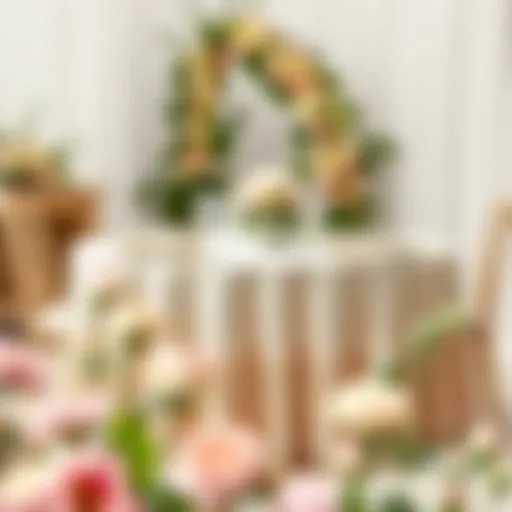The Fuzzy Cowboy Hat: A Unique Fashion Frontier
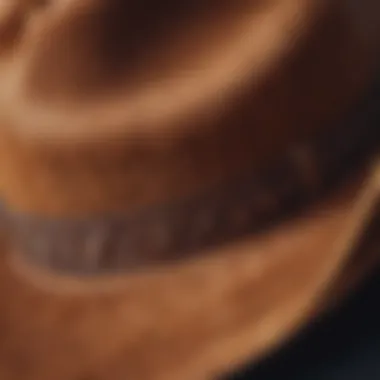

Intro
The fuzzy cowboy hat has emerged as a captivating symbol within the contemporary fashion landscape. It represents not just a practical piece of headwear but a fusion of rich cultural heritage and modern styling sensibilities. From cowboy culture in the American West to the fashion runways of today, this accessory has carved out a unique niche that enlivens both casual and high-end wardrobes. This article will unravel its journey, from rustic roots to trendy staple, illuminating its significance and versatility in today’s attire.
Fashion Trends and Insights
The fuzzy cowboy hat reflects a genuine accentuation as fashion cycles back to nostalgia yet intermingles with innovation. As nostalgia plays a significant role, today’s fashion enthusiasts are turned toward styles that tell stories and exhibit personality. In recent years, this trend has not only given birth to diverse interpretations of classic pieces but has also made room for accessories like the fuzzy cowboy hat to thrive.
Current Trends in Clothing Styles
In the style landscape, the fuzzy cowboy hat finds its place among other trending items. With more people stepping into the realm of individual expression, this hat complements various clothing styles:
- Bohemian Vibes: Combining soft fabrics and loose silhouette, the fuzzy cowboy hat elevates bohemian outfits to new heights.
- Streetwear Fusion: When paired with oversized hoodies or graphic tees, this hat forms a striking juxtaposition, creating bold urban aesthetics.
- Vintage Revival: Enthusiasts of retro styles are embracing classic combinations, where the fuzzy hat adds character to vintage dresses or well-worn denim.
Thanks to social media platforms, especially Instagram and TikTok, fashion lovers have immediate access to myriad styling options. This accessibility broadens the influence of the fuzzy cowboy hat across different demographics. Even retailers have honed in on this trend, showcasing the hat in combination with outfits ranging from high-end to affordable.
Influential Fashion Icons and Movements
The resurgence of the fuzzy cowboy hat in recent years can be attributed to various fashion icons who championed this piece. Stars like Kacey Musgraves and Lil Nas X have deftly integrated this iconic accessory into their wardrobes, capturing the attention of a broader audience. It’s important noting how their unique styles have launched a wave of admiration and mimicry in the fashion world. Additionally, this rise has given birth to new movements that embrace individualism, allowing people to assert their identities through clothing choices.
"Fashion is not just about clothes - it's about identity. The fuzzy cowboy hat symbolizes who we are today, blending tradition with contemporary flair."
Sustainable Fashion Practices
As the fashion industry pivots toward sustainability, the fuzzy cowboy hat is not exempt from this movement. Designers are beginning to adopt eco-friendly practices that align with the evolving conscientious mindset of the modern consumer. The decision to source sustainable materials for making these hats speaks volumes about the industry's growth.
Eco-Friendly Fabrics and Materials
Interestingly, several brands are prioritizing sustainable materials in their production. Some notable options include:
- Recycled Wool: Used to create soft, durable hats while reducing waste.
- Organic Cotton: Naturally grown without harmful chemicals makes for an eco-conscious option.
- Bamboo Fabric: An innovative fabric that not only feels soft but is also biodegradable.
Tips for Building a Sustainable Wardrobe
For those looking to integrate the fuzzy cowboy hat into a sustainable lifestyle, here are some tips:
- Choose Quality Over Quantity: Invest in durable items that can stand the test of time.
- Prioritize Ethical Brands: Research brands that have transparent practices regarding sourcing and production.
- Care and Repair: Maintain your pieces properly to prolong their life; this way, you minimize waste while enjoying what you love.
The evolving narrative around the fuzzy cowboy hat showcases how an accessory can transcend conventional expectations, adapting to both individual style and sustainability goals. As we observe its ascent, it becomes clear that this hat won't just fade into the background, instead continuing to shape the dialogue surrounding modern fashion.
Foreword to the Fuzzy Cowboy Hat
The fuzzy cowboy hat represents not just a unique accessory but a blend of heritage and modern sensibilities. For designers, retailers, and fashion enthusiasts, this hat offers a fresh twist on an iconic symbol of American culture. Understanding its defining characteristics and emergence is vital in appreciating what it adds to the contemporary wardrobe.
Defining the Fuzzy Cowboy Hat
At its core, the fuzzy cowboy hat differentiates itself with a tactile, often plush exterior that contrasts sharply with its structured origins. Typically made from synthetic fibers, wool, or felt, the fuzzy version has expanded beyond the traditional straw or leather designs one often associates with the cowboy aesthetic. This makes it not merely a hat but a statement piece that commands attention. Lacking the stiff brims of its predecessors, its soft and cozy appearance invites wearers to rethink how cowboy-style can feel.
Some might say it’s like wearing a hug on your head, combining comfort with style seamlessly. This lends itself to a broader audience, welcoming those who may not typically don a classic western hat. While the aesthetic may scream ruggedness, the fuzzy material adds a layer of playfulness that's particularly appealing to a younger crowd.
Initial Impressions and Popularity
When fuzzy cowboy hats first began cropping up in fashion circles, initial reactions ranged from curiosity to confusion. Many viewed them as just a quirky trend, something destined to fade into the annals of fashion history. However, it quickly became clear that these hats weren't just a flash in the pan. The unique materials and textures attracted interest not only from cowboy hat aficionados but also from those on the cutting edge of street fashion.
"The fuzzy cowboy hat has transformed from a mere accessory to a cultural touchstone, symbolizing a blend of old and new."
Social media played a pivotal role in the hat’s popularity. Influencers began sporting them in stylish settings, showcasing their versatility—from music festivals to casual brunch outings. This exposure helped reinforce the idea that the fuzzy cowboy hat can fit into various environments, breaking the stereotype of being just a country or rodeo piece.
Trends such as pastel tones and unique embellishments also helped underscore the hat's appeal. Fashion-forward consumers embraced it wholeheartedly, sparking a movement that merged nostalgia with innovation. As they fostered this revival of an American classic, the fuzzy cowboy hat carved out its niche in today’s fashion landscape, inviting individual expression while celebrating a deep-rooted tradition.
Historical Context
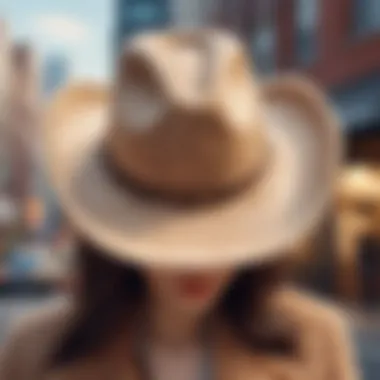

Understanding the historical context of the furry cowboy hat is vital for grasping its unique place in modern fashion. This segment paints a picture of where this distinctive accessory comes from, enriching our appreciation for its design and cultural relevance. By knowing the trajectory of the cowboy hat, we can better grasp its evolution into the cozy and eclectic fuzzy variant we see gracing heads today.
Origins of the Cowboy Hat
The cowboy hat has its roots deeply embedded in the rugged landscapes of the American West. Originally, this staple piece of headgear evolved from various influences, drawing from traditional Mexican sombreros as well as European styles. These influences combined to form a practical yet stylish accessory for those working outdoors in harsh conditions. The classic high crown and wide brim served dual purposes: protecting the wearer from the scorching sun and serving as protection against rain and other harsh elements. In its initial form, the cowboy hat was about functionality. As ranching grew in popularity, it became a symbol of the American cowboy—the embodiment of freedom and adventure.
The materials used in its earliest iterations—straw, leather, or felt—varied by region and climate, but all shared a common purpose: durability. From the sun-baked plains to the snowy mountain slopes, the cowboy hat adapted to suit the needs of its wearers. As ranchers and cowboys traveled across uneven terrains, the hat evolved not just as a shield against nature but as an emblem of a lifestyle, carrying with it tales of toil and triumph.
Evolution to the Fuzzy Style
As the years rolled on, the cowboy hat underwent numerous modifications. By the late 20th century, we began seeing a shift in how this accessory was perceived. Instead of being solely utilitarian, the hat morphed into a fashion statement. The fuzzy cowboy hat emerged as a more whimsical interpretation, embracing enthusiasm and creativity. This transformation was driven by changing cultural attitudes towards self-expression in fashion.
The rise of alternative fashion movements and a growing appreciation for vintage styles paved the way for the fuzzy variant. Designers began experimenting with plush fabrics, bringing a softness and warmth that was previously absent in the sturdy felt or straw models. Think of it as a marriage between the rugged cowboy ethos and contemporary flair. The result is a head-turning accessory that stands out in urban settings, as much as it does in rural landscapes.
Fuzzy hats now represent a blend of nostalgia, innovation, and a playful approach to dressing. As the innovation of materials continues to evolve, one thing remains clear: the cowboy hat, especially in its fuzzy form, captures the spirit of individuality and adventure that consumers today are so eager to express.
"Fashion isn't just about what you wear; it's about how you tell your story. The fuzzy cowboy hat does exactly that, mixing tradition with an expressive twist."
The journey from the practical cowboy hat to its flamboyant fuzzy counterpart reflects broader changes in society's values. As trends come and go, the fuzzy cowboy hat remains a versatile symbol of creativity and personal expression in the realm of fashion.
Cultural Significance
The fuzzy cowboy hat stands as more than just an accessory; it embodies a rich tapestry of cultural narratives and evolving tastes. In the realm of fashion, understanding its cultural significance provides crucial insights into why it resonates with modern sensibilities. This section explores the deeper layers of its meaning, connecting the past, the present, and the future in a way that's both interesting and relevant.
Symbolism in Western Culture
The symbolism packed into the fuzzy cowboy hat can’t be overstated. At its core, it links to the traditions of the American West—an area marked by rugged individualism and vast landscapes. Unlike the sleek urban styles that dominate runways, the fuzzy cowboy hat channels a nostalgic sense of adventure, drawing on themes of freedom and escapism.
- Elements of Identity: Wearing this hat isn’t merely about fashion; it represents a choice to embody characteristics often associated with cowboys: resilience, a connection to nature, and independence. It’s an identity wrapped in fabric, harder to pin down than a needle in a haystack.
- Cultural Heritage: The fuzzy cowboy hat serves as a nod to a specific heritage, showcasing the fusion of utility and style that ranchers and farmers relied on. When someone dons a fuzzy cowboy hat, they invite a sense of community and shared history, even if they're just strolling down a city street.
Representation in Media
Films and Television
In films and television, the fuzzy cowboy hat has emerged as a powerful icon, representing concepts that go far beyond its physical presence. One of the most notable attributes of these media is their ability to transport audiences into different times and places. Western movies often employ the hat as a vital prop, defining characters and influencing plot dynamics.
- Iconic Visuals: Think of John Wayne in the classic Westerns or more recent examples like Hell or High Water—the fuzzy cowboy hat makes a mark. The way it's showcased accentuates character traits, making those wearing it seem rugged and authentic.
- Cultural Context: The fuzzy cowboy hat in media often comes laden with connotations; it's sometimes viewed as a relic or even a stereotype. While this can offer depth, it can also pigeonhole the imagery of Western culture, creating potential misconceptions about its significance.
Music Influences
The musical scene, too, plays a considerable role in elevating the status of the fuzzy cowboy hat. From country legends to modern pop culture icons, its presence in lyrics and performances creates an impactful narrative about identity, lifestyle, and tradition.
- Cultural Relevance: Artists such as Dolly Parton and Garth Brooks have used this hat to cultivate a distinctive image that resonates with their audience, making it a cultural touchstone. The fuzzy cowboy hat serves not only as a fashion statement but also as a tool for storytelling in songs that depict life experiences.
- Diverse Nuance: Today’s music videos often blend different genres, showcasing fuzzy cowboy hats alongside urban aesthetics. This blend creates an intriguing duality, occasionally straddling the line between appreciation and appropriation. Ultimately, it can be a double-edged sword—a cherished emblem or a mere trend.
In the cinematic and musical universe, the fuzzy cowboy hat is more than an accessory; it’s a vessel of narratives waiting to be explored.
Materials and Construction
In the journey of understanding the fuzzy cowboy hat, we must zero in on its materials and construction. These elements are not just about fashion but hold a significant role in defining the texture, durability, and overall aesthetic appeal of this unique accessory. Today’s consumer is more discerning than ever, and they seek hats that not just look good but also resonate with their values about sustainability and craftsmanship.
Common Fabrics Used
The fuzzy cowboy hat typically embraces a range of materials. Faux fur, wool blends, and high-quality felts are often the stars of the show. These materials are favored for their warmth and luxurious feel.
- Faux Fur: A popular choice, faux fur gives the hat that cozy, fuzzy look without using animal products. This is vital for environmentally-conscious consumers who want to enjoy the cowboy aesthetic without compromising their beliefs.
- Wool Blends: These often marry soft texture with breathability, making the hats comfortable for varying weather conditions. Additionally, they provide warmth without being overly heavy.
- Felt: Classic cowboy hat materials, felt often comes from wool or fur. It allows for shaping and designing while providing a classic, sophisticated touch to the overall appearance.
The choice of fabric can also influence the hat’s price range. Hats made from premium materials often come with a heftier price tag, but this investment typically translates to higher quality and longevity.
Manufacturing Techniques
When it comes to the manufacturing of fuzzy cowboy hats, the process often falls into two main categories: handcrafted and mass production. Each method has its own merits and drawbacks, shaping the final product in unique ways.
Handcrafted vs. Mass Production
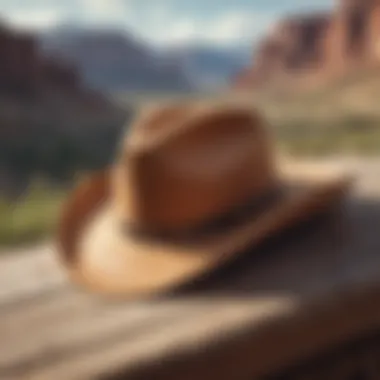

Handcrafted hats often emerge from the skilled hands of artisans who take their time to create each piece. This method contributes to the charm of fuzzy cowboy hats, as each one tells a story woven into its fibers. The key characteristic of handcrafted pieces is the attention to detail.
On the flip side, mass production allows for faster turnaround times and often lower costs. However, the lack of personal touch can sometimes leave these hats feeling less unique. While mass-produced hats may cater to a broader market, they run the risk of sacrificing authenticity.
“A handcrafted hat is not just something you wear; it’s a piece of art that carries the spirit of its maker.”
Sustainability Considerations
In recent years, sustainability has emerged as a cornerstone in fashion. When it comes to the fuzzy cowboy hat, manufacturers are starting to embrace more eco-friendly practices. This aspect is crucial for the modern consumer who is increasingly aware of the impact their purchases make on the planet.
Using sustainably sourced materials and adopting ethical labor practices are two critical components of this approach. Here’s what makes sustainability so potent in the context of fuzzy cowboy hats:
- Material Choices: Opting for recycled fabrics or organic materials can drastically reduce waste and environmental impact.
- Ethical Production: Handcrafted hats may often support local economies, allowing artisans to benefit from their work rather than large corporations profiting disproportionately.
- Longevity: A focus on quality can lead to products that last longer, reducing the need for frequent replacements which aligns with sustainable practices.
Styling the Fuzzy Cowboy Hat
Styling the fuzzy cowboy hat holds a pivotal role in understanding its significance within contemporary fashion. Not just a headpiece, it embodies a blend of tradition and modernity, serving as a versatile accessory that can elevate various outfits. The way one styles this hat can transform an ensemble, marking it a key conversation starter and an avenue for self-expression. As we explore the nuances of styling the fuzzy cowboy hat, it’s important to consider how different outfit pairings can enhance its unique aesthetic.
Pairing with Outfits
Casual Wear Accessories
When discussing casual wear accessories, the fuzzy cowboy hat emerges as a standout choice. Its playful appeal makes it an easy addition to everyday outfits, from denim shorts and a simple tee to sundresses. For women and men alike, this hat brings a lively flair while maintaining a relaxed vibe. A distinctive characteristic of the fuzzy cowboy hat in casual settings is its ability to add a whimsical touch—a friendly nod to Western heritage while still feeling fresh.
By incorporating elements like fringe bags, chunky boots, or layered necklaces, individuals can create an effortlessly cool look. While it’s an excellent choice for casual styling, the hat does come with one drawback: it can be less suitable for more refined or office-appropriate settings. Nonetheless, for backyard barbecues or informal gatherings, its laid-back charm shines.
Dressier Styles
Transitioning into dressier styles, the fuzzy cowboy hat proves to be just as versatile. When paired with tailored blazers, fitted trousers, or even cocktail dresses, it can redefine sophisticated looks. The key characteristic here is its unexpected twist on formal attire, challenging conventions of how accessories are traditionally styled in elegant settings. This uniqueness makes it a favored choice among trendsetters who seek to make a bold statement while maintaining an air of sophistication.
One unique feature of dressing up with the fuzzy cowboy hat is its capacity to blend high fashion with regional identity. It turns heads at galas or upscale events, offering a stylish contrast to more conventional headgear. However, a consideration worth noting is that not everyone may resonate with such an unconventional statement, so a degree of confidence is necessary to pull it off effectively.
Unisex Appeal
The appeal of the fuzzy cowboy hat extends across gender lines, promoting a sense of inclusivity in fashion. This unisex design resonates well with both men and women, allowing individuals to express personal style without the constraints of traditional gender norms. Whether it’s through the choice of colors or the style's adaptability, the fuzzy cowboy hat embraces a wider audience, making it a symbolic piece in contemporary wardrobes. As we step into a world where self-expression reigns supreme, the unifying aspect of this hat's design will likely serve to enhance its prominence in future fashion dialogues.
Current Trends
The fuzzy cowboy hat has carved a niche for itself in the ever-changing landscape of fashion. It's not just a quirky accessory; it's become a symbol of creativity and personal expression. Understanding the current trends surrounding this unique item is crucial for anyone involved in fashion, whether you’re a designer, retailer, stylist, or influencer. This section offers an in-depth look at how the fuzzy cowboy hat is reshaping style narratives and how it continues to gain traction in various circles.
Celebrity Influences
Celebrities play a pivotal role in driving trends, and the fuzzy cowboy hat is no exception. As stars embrace this bold fashion statement, they make it a staple in their wardrobes, which in turn influences their fan base and the wider public. Take, for example, the likes of Billie Eilish and Lil Nas X, who are not shy about flaunting their fuzzy hats on various platforms. Their influence is monumental, signaling a shift in how traditional cowboy aesthetics can blend with modern streetwear vibes.
These high-profile endorsements turn the fuzzy cowboy hat into a must-have item, encouraging fans to adopt similar styles. Moreover, when magazines feature these celebrities donning the hats on their covers, it adds a layer of legitimacy and desirability. This creates a positive feedback loop in which the more visibility the hat gets, the more consumers seek it out in stores and online.
"Fashion is ever-evolving, and the fuzzy cowboy hat is the latest twist on tradition, bridging the gap between old and new."
Runway Appearances
The transition of the fuzzy cowboy hat from casual wear to high fashion is marked by its appearance on runways. Fashion weeks in major cities like New York, Milan, and Paris have showcased creative interpretations of the hat, fueling its ascent in the world of couture.
Designers are reimagining the fuzzy cowboy hat, experimenting with different materials and embellishments. These runway styles often see the hat paired with unexpected garments, breaking norms and setting new standards. For instance, a fuzzy cowboy hat might be seen atop a sleek, tailored suit or a flowing evening gown.
The aesthetics on the runway usually trickle down to mainstream fashion trends. Retailers watch closely how these styles manifest during fashion weeks and adapt them for their collections. This ever-present interplay between high fashion and consumer trends highlights the fuzzy cowboy hat's journey: from niche item to a versatile accessory that currently holds a prominent place in fashion narratives.
In short, the current trends surrounding the fuzzy cowboy hat reflect a broader shift in fashion—one that embraces individuality while pulling from traditions. Whether it's through celebrity influence or runway glamour, this accessory does more than just add flair; it encapsulates a movement towards bold expressions in style.
Consumer Approaches
Understanding consumer approaches to the fuzzy cowboy hat provides valuable insights into the evolving dynamics of fashion. In the realm of contemporary style, where individuality often holds the highest esteem, these approaches can articulate how buyers perceive value, aesthetics, and the emotional resonance of this accessory. The fuzzy cowboy hat does not only stand as a piece of clothing but also serves as a conversation starter, a statement of identity, and a symbol intertwined with culture.
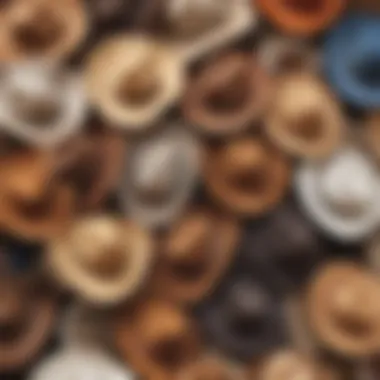

Market Demographics
The demographics surrounding the fuzzy cowboy hat reveal a diverse group of consumers. Unlike traditional cowboy hats that primarily cater to rural or western regions, the fuzzy version has expanded its appeal across urban settings as well. Young adults and influencers who thrive on social media platforms such as Instagram and TikTok reign as major stakeholders in this market. Beneath the surface, millennial and Gen Z consumers lean into vintage aesthetics and sustainable fashion choices, which are significant attributes of the fuzzy cowboy hat. A blend of age groups, gender identities, and cultural backgrounds contributes to how this accessory is adopted.
Notable stats include:
- Age Range: Predominantly 18 to 35 years old.
- Gender Appeal: Strong unisex characteristics attracting diverse groups.
- Cultural Blend: Appeal manifests not only in western style enthusiasts but also in urban-fashion circles.
Purchasing Trends
Examining purchasing trends unveils how buyers opt for their fuzzy cowboy hats based on convenience, accessibility, and personal preference. Online shopping has surged, fueled by the pandemic enabling consumers to seek fashionable items from the comfort of their homes. Nonetheless, in-store experiences remain crucial, especially for those who cherish the tactile sensation of materials.
Online vs. In-store
The aspect of online vs. in-store sales is particularly telling. Online shopping allows for a wider selection and the ease of comparing prices. The key characteristic is convenience, letting shoppers browse various options without stepping outdoors. However, the unique feature of in-store shopping lies in the personal connection to the fabric and the ability to try the hat on, crucial for ensuring the right fit. The advantages of online shopping include potentially lower prices and the avoidance of crowds, while in-store shopping offers immediate gratification and a tangible assessment of quality.
"In the end, both online and in-store experiences shape consumer behavior, ensuring that each hat finds its unique owner."
Regional Variations
Diving into regional variations further illustrates how consumer behaviors can diverge. In areas rich with Western heritage, the fuzzy cowboy hat enjoys higher popularity, often seen as a stylish accessory rather than merely a functional item. In contrast, city dwellers might gravitate more towards subtle, chic designs that resonate with urban fashion.
The key characteristic of these regional variations lies in cultural acceptance—how well a fuzzy cowboy hat integrates into local fashion norms. In the Southwest United States, this hat can dominate fashion trends at festivals, whereas in metropolitan areas like New York City, it often surfaces more as a bold statement piece rather than everyday wear. Each geographical region contributes its unique flavor and aesthetic to the acceptance of the fuzzy cowboy hat, creating a rich tapestry of consumer behavior.
In summary, understanding consumer approaches, including demographics and purchasing patterns, offers a multifaceted view of the fuzzy cowboy hat's role in modern fashion. These insights reflect not just a trend but a growing dialogue between tradition and contemporary style.
The Future of Fuzzy Cowboy Hats
The fuzzy cowboy hat isn't just a playful addition to one’s wardrobe; it stands at a critical point between tradition and modernity in fashion. Understanding its future means grasping how it can embody both nostalgic charm and contemporary relevance. As society goes through shifts in style sensibilities fueled by cultural dialogues, the fuzzy cowboy hat must adapt and innovate to stay in tune with these changes. This section looks at the crucial elements influencing its evolution, promising benefits for designers and retailers alike, and important considerations to maximize the category's appeal.
Innovative Designs
The prospect of innovative designs in fuzzy cowboy hats is an exciting frontier in itself. Designers are not just playing with soft materials, they're pushing the envelope. Think beyond mere texture—new designs integrate functionality and aesthetic appeal. For instance, certain hats come equipped with adjustable bands or moisture-wicking linings aimed at enhancing wearability while keeping the style quotient high. A popular trend features dried flowers or fabric embellishments suggesting wild nature’s beauty, thus creating a unique blend of ruggedness and elegance.
Consumers are increasingly leaning towards personalized fashion, which invites opportunities for customizable options. Imagine a scenario where you could choose colors, shapes, or even monogramming on the hats. Such initiatives could cater to personal tastes and allow individuals to showcase their creativity.
Sustainability Efforts
The future of fuzzy cowboy hats also hinges significantly on sustainability efforts. Today's consumers are more aware of the environmental footprint of their purchases. In response, companies are being challenged to adopt eco-friendly materials and ethical manufacturing processes. There’s a noticeable shift towards using recycled fibers or organic textiles in production. Bamboo, for instance, is gaining traction for its renewability and soft texture.
Many brands are also implementing fair trade practices to promote social responsibility within their supply chains.
"Fashion is a reflection of society's values; with sustainability being a priority, the fuzzy cowboy hat can pave the way forward."
Wrapping Up
As we bring our exploration of the fuzzy cowboy hat to a close, it's essential to reflect on how this unique accessory has carved out a significant niche in fashion. The fuzzy cowboy hat embodies transformations in cultural norms, aesthetics, and individual expression. Within this realm, one finds not just a hat, but a symbol of a distinct lifestyle that merges Western tradition with a modern twist. It's a conversation starter, a source of comfort, and a piece of clothing that can adapt to varied styles and settings.
Final Thoughts on the Fuzzy Cowboy Hat
The fuzzy cowboy hat signifies more than mere style; it represents a fusion of the old and the new. This accessory stands at the crossroad of heritage and innovation, capturing the essence of what it means to redefine fashion. Its resurgence isn't merely a trend; it's a statement about where we are as a society—embracing nostalgia while forging forward with creative flair.
Notably, the fuzzy textures and varied materials resonate with a diverse audience, making it appealing to individuals from all walks of life. As more designers, retailers, and influencers adopt this aesthetic, its impact on contemporary style will likely continue to grow.
Encouragement to Explore Styles
Fashion is, at its heart, a personal journey. The fuzzy cowboy hat offers a fantastic opportunity to engage in self-expression and creativity. Here are a couple of ways to really make an impression:
Personal Interpretation
Personal interpretation profoundly shapes how we approach fashion. When someone chooses to style a fuzzy cowboy hat, they often do so with either nostalgia or imaginative flair. This specific aspect allows individuals to reinterpret traditional elements in ways that speak to their own experiences. The key characteristics of personal interpretation revolve around its flexibility and uniqueness.
It encourages people to mix and match their outfits, resulting in an ensemble that’s wholly their own. While some may opt for a laid-back bohemian look, others might dress it up with tailored outfits, which can create a striking visual. However, a potential drawback is that sometimes, this interpretation may not resonate with everyone, leading to a disconnect between personal style and mainstream trends.
Embracing Individuality
Embracing individuality is crucial in today's interconnected world. The fuzzy cowboy hat not only represents a specific style but also serves as a canvas for self-expression. The key characteristic here is its ability to stand out; wearing it can signify confidence and a refusal to blend into the crowd. One unique feature of embracing individuality through such accessories is its capacity to tell a story. Each hat can embody a different narrative, reflecting the wearer's journey and identity.
Advantages of this approach include the ability to foster connections with like-minded individuals, whether through shared interests or aesthetics. However, in some situations, like formal gatherings, the fuzzy cowboy hat might not convey the intended message, potentially causing the wearer to feel out of place.



